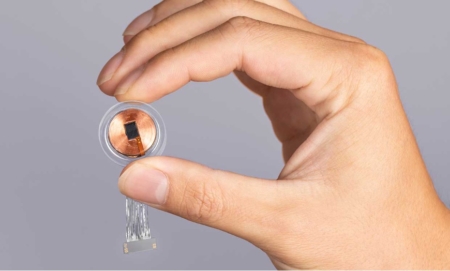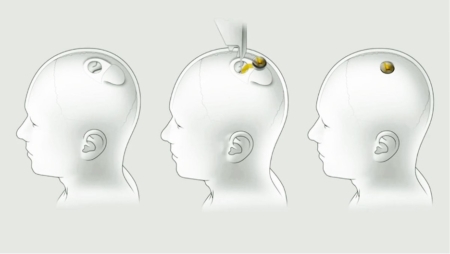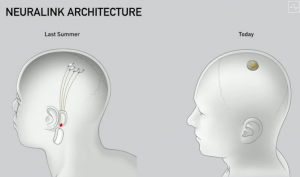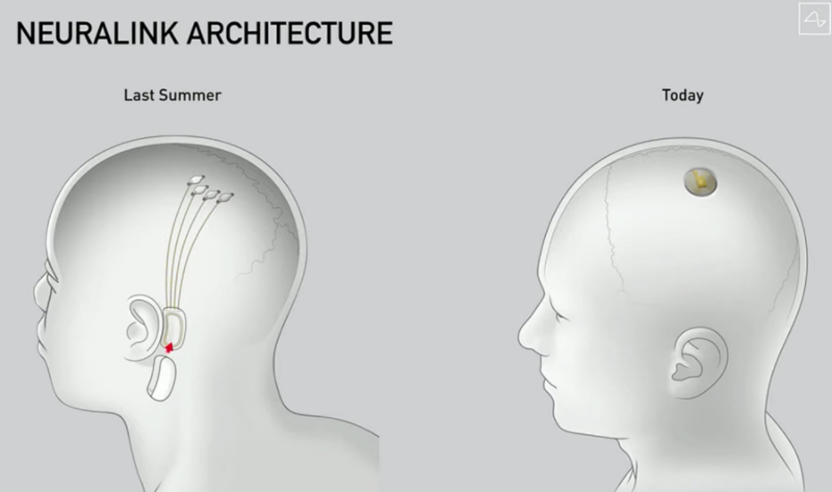Mad Hedge Technology Letter
December 20, 2023
Fiat Lux
Featured Trade:
(FUTURE OF AI PATENTS AND LAW)
(CHINA), (NEURALINK)

Mad Hedge Technology Letter
December 20, 2023
Fiat Lux
Featured Trade:
(FUTURE OF AI PATENTS AND LAW)
(CHINA), (NEURALINK)

The world is rapidly shifting into a new paradigm where not only do people invent, but people also build artificial intelligence that can invent.
This will have massive ramifications for the business world and the tech industry which is the avant-garde of the business world.
Recent decisions from South Africa and Australia that an artificial intelligence machine can be listed as an inventor on a patent could spur these two locales into being one of the most competitive tech scenes in the world.
The U.S. and Europe will need to figure out what it means to be an inventor.
Registering A.I. as an inventor could potentially mean that multinational corporations won’t shoulder the blame if some sort of insidious experiment with A.I. goes horribly wrong crushing half of mankind.
It also opens up the possibility of some “A.I. invented” app triggering 1000X growth delivering prosperity to half of mankind.
The wide range of possibilities is enough to keep one up at night, and the deeper knock-on effect is that A.I. is now prime for game time.
The rapid acceleration of not only the quantity of A.I., but the increasing quality of A.I. means that countries will need to make some high-stakes business decisions on where A.I. fits into the law and patent system.
Courts in the U.S. and U.K. are expected to issue rulings later this year, and policymakers are gathering information on how to deal with the rising use of AI.
Another piece to the puzzle is how China will treat A.I. and the knock-on effects on American consumers and American businesses.
This sub-sector has been identified as one of the “must-win technologies of the future” by the U.S. administration.
China also leads in AI as it relates to facial recognition and has a database of 1.3 billion citizens to pull data from.
China is pursuing a centrally controlled strategy with hyperlocal implementation. Values and goals are set from above, and resources are made available.
At the local level of municipalities, cities, and provinces, regional administrations compete for the new AI clusters.
The result is a national and regional administrative state that works closely with research, investors, and industry to build a successful AI ecosystem.
In either case, American companies need a verdict and the initial framework of how to treat A.I. in terms of who owns the patents and what that means, or they risk falling behind places like China which is hell-bent on being the first A.I. superpower.
Imagine if all companies were protected from anything negative that AI manufactured and not only with social media.
One could understand how investors could win out big time if a flood of capital nosedived into controversial projects that became money generators.
Big tech has the capital and connections in Washington to advance the initiative.
Another project that comes to mind that would benefit from AI law is Elon Musk-supported Neuralink.
Elon Musk wants everyone to get brain surgery. Specifically, he wants everyone to get a brain implant — the brain-machine interface created by his company, Neuralink. He says it will be able to solve any number of medical conditions — including paralysis, anxiety, and addiction.
A project like this is high risk — a lot could go wrong with it.
But what if the law was set up to just allow investors to write off the externalities and fiscal costs of a failed project?
These rulings also have massive consequences in where the new Silicon Valley migrates to and if the rules are favorable in South Africa, what’s stopping Facebook from exploring an opening of a Cape Town subsidiary?
Not much is the answer.
The issue of inventorship is just a small part of the dilemma over how to deal with AI, such as what types of AI software are eligible for a patent and who owns the massive amounts of data required to “teach” the machines.
A decision clarifying which AI inventions are eligible for patenting would be impactful.
Ultimately, AI is a high-stake game that gets more important by the day and so far there has been nothing detrimental that will affect the fortunes of big tech and their quest for higher share prices.

Mad Hedge Technology Letter
July 20, 2022
Fiat Lux
Featured Trade:
(HUMAN TESTING COULD START SHORTLY)
(NEURALINK)

Neuralink Corporation is an American neurotechnology company developing implantable brain-machine interfaces.
You would think this is straight out of science fiction, but mark my words that in our lifetime, we could all be operating digital Neuralink devices from our heads if Musk gets his way.
And he often does get his way.
Scary as it seems now, this will probably be the first of many artificial intelligence procedures to infuse humans with layers of artificial intelligence.
Musk believes humans will go the way of robot hybrid in the future because the natural development of competition is trending in that way and sadly, this direction in humanity is ultimately existential for every one of us.
Improvements in technology will periodically be announced and iterations will need to be adopted because software is upgraded.
As for today and now, testing on pigs has segued into testing on monkeys.
Pending FDA approval, Musk hopes to start testing Neuralink on humans with severe spinal-cord injuries like tetraplegics and quadriplegics in 2023.
Neuralink’s dramatically simplified design for an implant that hopes to create brain-to-machine interfaces is a big deal and partly because of the star power backing the project that can literally move mountains.
The previous design consisted of a bean-shaped device that would sit behind the ear, but now it is the size of a large coin, and it goes in your skull.
I expect the final iteration to be a millimeter wide.
The in-brain device could enable humans with neurological conditions to control technology, such as phones or computers, with mere thoughts.
The other use case is solving neurological disorders from memory, hearing loss, and blindness to paralysis, depression, and brain damage which is a tad more altruistic.
The current prototype – referred to as version 0.9 – measures 23 millimeters by eight millimeters and has 1024 electrode "threads" attached to it that are implanted into the brain.
It is designed to replace a coin-sized portion of the skull and sit flush so it would be physically unnoticeable. It would be inductively charged the same way you would wirelessly charge a smartwatch or a phone.
The surgical robot, which is programmed to insert the neural threads safely into the brain, was done by US design company Woke Studios.
Woke Studio’s robot would be able to insert the link in under an hour without general anesthesia, with the patient able to leave the hospital right away.
The robot will eventually do the entire surgery – so everything from the incision, removing the skull, inserting electrodes, placing the device, and then closing things up.
It will be completely automated.
In 2021, humans still need to digest thoughts and carry out functions through actionable fingers into a phone interface.
Not only will physical devices be useless at that point, but they will also spawn a mega cloud storage business that is hooked straight to the mind.
It really is a gigantic step that will digitize, even if marginally ethical, and computerize humans.
Lately, reports in 2022 show that Neuralink killed eight monkeys during research experiments at UC Davis labs in California.
Neuralink has since denied accusations of animal cruelty and moved lab experiments to Fremont, California.
However, a recently filed lawsuit by Physicians Committee for Responsible Medicine (PCRM) follows up with those accusations of animal abuse.
No doubt this will delay any further testing with monkeys and delay the inevitable transition of brain-altered humans.
Musk also got one of his Neuralink executives pregnant and fathered twins.
Who said life was simple!


Neuralink Corporation is an American neurotechnology company developing implantable brain-machine interfaces.
You would think this is straight out of science fiction, but mark my word that in our lifetime, we could all be operating digital devices from our heads if Musk gets his way.
And he often does get his way.
Scary as it seems now, this will probably be the first of many artificial intelligence procedures to infuse humans with layers of artificial intelligence.
Musk believes humans will go the way of robot hybrid in the future because the natural development of competition is trending in that way and sadly, this direction in humanity is ultimately existential for every one of us.
Improvements in technology will periodically be announced and iterations will need to be adopted because software is upgraded.
As for today and now, testing on pigs has segued into testing on monkeys.
Musk has told us the monkey testing has gone “well.”
Pending FDA approval, Musk hopes to start testing humans with severe spinal-cord injuries like tetraplegics, quadriplegics in 2022 which would represent a monumental step in this technology.
Earlier this year, a 20-person biotech firm called Synchron secured approval from the FDA to start human testing, so the stakes are high and imminent.
Neuralink’s dramatically simplified design for an implant that hopes to create brain-to-machine interfaces is a big deal and partly because of the star power backing the project that can literally move mountains.
The previous design consisted of a bean-shaped device that would sit behind the ear, but now it is the size of a large coin, and it goes in your skull.
I expect the final iteration to be a millimeter wide.
The in-brain device could enable humans with neurological conditions to control technology, such as phones or computers, with mere thoughts.
The other use case is solving neurological disorders from memory, hearing loss, and blindness to paralysis, depression, and brain damage which is a tad more altruistic.
The current prototype – referred to as version 0.9 – measures 23 millimeters by eight millimeters and has 1024 electrode "threads" attached to it that are implanted into the brain.
It is designed to replace a coin-sized portion of the skull and sit flush so it would be physically unnoticeable. It would be inductively charged the same way you would wirelessly charge a smartwatch or a phone.
The surgical robot, which is programmed to insert the neural threads safely into the brain, was done by US design company Woke Studios.
Woke Studio’s robot would be able to insert the link in under an hour without general anesthesia, with the patient able to leave the hospital right away.
The robot will eventually do the entire surgery – so everything from the incision, removing the skull, inserting electrodes, placing the device, and then closing things up.
It will be completely automated.
If this technology is green-lighted by the U.S. Federal Government, I envision a free for all into this technology from the likes of Facebook, Google, Apple, and Microsoft, and so on.
If you thought website “cookie tracking” is bad now, then once tech firms are granted access to consumers’ brains, it could open up a pandora's box of moral conflicts of interest, an avalanche of revenue opportunities, and lawsuits galore.
Look at the hesitation and disgruntlement of the health industry hoping to convince Americans to take two jabs of an mRNA vaccine in the arm and now think about trying to convince humans to implant a chip in their head for the sake of competing.
Will American society really get to the point where Facebook is selling your “thoughts” to neural advertisers?
It’s scary to think about but that is the direction we are headed down for better or worse.
If you view this through the lens of big tech, battering down the hatches to get access to consumers’ “thoughts” is the holy grail of access points and revenue flow.
In 2021, humans still need to digest thoughts and carry out functions through actionable fingers into a phone interface.
We have also allowed big tech into our home feeding them data through smart devices and virtual assistants like Amazon Alexa.
Getting rid of all that “fluff” and extracting data and behavioral results from the original source is potentially worth over 20 trillion dollars along with a recurring revenue source to infinity.
Not only will physical devices be useless at that point, but they will also spawn a mega cloud storage business that is hooked straight to the mind.
An economic analyst can digest how cloud companies like Amazon and Google would rake in the trillions by storing libraries of data that a mind can tap in at any time.
It really is a gigantic step that will digitize, even if marginally ethical, and computerize humans - big tech is first in line to reap the profits and literally control our brains.
This is the future – a future where we coexist with artificial intelligence and brain chips.


Mad Hedge Technology Letter
July 23, 2021
Fiat Lux
Featured Trade:
(NEURALINK WILL CHANGE THE WORLD AND YOUR BRAIN)
(TSLA), (SPACEX), (NEURALINK), (BORINGCOMPANY)

Founder of Tesla Elon Musk is on record confessing that it would be a “good idea” to bring his four businesses — Tesla, SpaceX, Neuralink, and The Boring Company — under a giant holding company.
Doing this would encourage more talented engineers to work for Musk and allow the four companies to combine human resources and marketing departments.
The synergies would be countless.
Most of you know three of the four, so let me explain to you about Neuralink.
In short, Neuralink Corporation is an American neurotechnology company developing implantable brain-machine interfaces.
You would think this is straight out of science fiction, but mark my word that in our lifetime, we could all be operating digital devices from our heads if Musk gets his way.
And he often does get his way.
Scary as it seems now, this will probably be the first of many artificial intelligence procedures to infuse humans with layers of artificial intelligence.
Musk believes humans will go the way of robot hybrid in the future because the natural development of competition is trending in that way and sadly, this direction in humanity is ultimately existential for every one of us.
Improvements in technology will periodically be announced and iterations will need to be adopted because software is upgraded.
Fortunately, we are nowhere close to the actual implementation of these neuro devices let alone trying to analyze the consumer and economic implications of this technology.
As for today and now, we are in the early innings and testing it out on pigs.
Better them and not me.
Neuralink’s dramatically simplified design for an implant that hopes to create brain-to-machine interfaces is a big deal and partly because of the star power backing the project that can literally move mountains.
The previous design consisted of a bean-shaped device that would sit behind the ear, but now it is the size of a large coin, and it goes in your skull.
I expect the final iteration to be a millimeter wide.
The in-brain device could enable humans with neurological conditions to control technology, such as phones or computers, with mere thoughts.
The other use case is solving neurological disorders from memory, hearing loss, and blindness to paralysis, depression, and brain damage which is a tad more altruistic.
The current prototype – referred to as version 0.9 – measures 23 millimeters by eight millimeters, and has 1024 electrode "threads" attached to it that are implanted into the brain.
It is designed to replace a coin-sized portion of the skull and sit flush so it would be physically unnoticeable. It would be inductively charged the same way you would wirelessly charge a smartwatch or a phone.
The surgical robot, which is programmed to insert the neural threads safely into the brain, was done by US design company Woke Studios.
Woke Studio’s robot would be able to insert the link in under an hour without general anesthesia, with the patient able to leave the hospital right away.
The robot will eventually do the entire surgery – so everything from the incision, removing the skull, inserting electrodes, placing the device, and then closing things up.
It will be completely automated.
Test pigs are being used to test the device which offers important insights into the process of inserting a chip into a brain.
The implant sends real-time signals from the pig’s brain whenever it touches something with its snout.
Described as "healthy and happy", one of the pigs demonstrated that it is possible to have multiple chips in your head at one time.
Musk also showed a pig that previously had a chip inserted into its brain, but had since been removed, to show that the procedure is reversible without any serious side effects.
Neuralink’s Breakthrough Device designation by FDA supports Musk’s neuroscience objectives. The startup is now preparing for its first human test case, pending required approvals, and further safety testing.
If this technology is green-lighted by the U.S. Federal Government, I envision a free for all into this technology from the likes of Facebook, Google, Apple, and Microsoft, and so on.
If you thought website “cookie tracking” is bad now, then once tech firms are granted access to consumers’ brains, it could open up a pandora's box of moral conflicts of interest, an avalanche of revenue opportunities, and lawsuits galore.
Look at the hesitation and disgruntlement of the health industry hoping to convince Americans to take two jabs of an mRNA vaccine in the arm and now think about trying to convince Americans to implant a brain in their head for the sake of competing.
Will American society really get to the point where Facebook is selling your “thoughts” to neural advertisers?
It’s scary to think about but that is the direction we are headed down for better or worse.
If you view this through the lens of big tech, battering down the hatches to get access to consumer’s “thoughts” is the holy grail of access points and revenue flow.
In 2021, humans still need to digest thoughts and carry out functions through fingers into a phone interface.
We have also allowed big tech into our home feeding them data through smart devices and virtual assistants like Amazon Alexa.
Getting rid of all that “fluff” and extracting data and behavioral results from the original source is potentially worth over 10 trillion dollars along with a recurring revenue source to infinity.
Not only will physical devices be useless at that point, but they will also spawn a mega cloud storage business that is hooked straight to the mind.
An economic analyst can digest how cloud companies like Amazon and Google would rake in the trillions by storing libraries of data that a mind can tap in at any time.
It really is a gigantic step that will digitize and computerize humans - big tech is first in line to reap the profits and literally control our brains.
Maybe by that time, the government will actually lift a finger and regulate since the current crop of Baby Boomers still have no idea what Facebook does and have been turning a blind eye.
This is the future – a future where we coexist with artificial intelligence.


Mad Hedge Technology Letter
December 30, 2020
Fiat Lux
Featured Trade:
(HOW NEURALINK WILL CHANGE THE WORLD)
(TSLA), (SPACEX), (NEURALINK), (BORINGCOMPANY)

Founder of Tesla Elon Musk tweeted a few days ago that it would be a “good idea” to bring his four businesses — Tesla, SpaceX, Neuralink, and The Boring Company — under a giant holding company.
Doing this would encourage more talented engineers to work for Musk and allow the four companies to combine human-resources and marketing departments.
Most of you know three of the four, so let me explain to you about Neuralink.
In short, Neuralink Corporation is an American neurotechnology company developing implantable brain-machine interfaces.
You would think this is straight out of science fiction, but mark my words that in our lifetime, we could all be operating digital devices from our heads if Musk gets his way.
Scary as it does seem now, this will probably be the first of many artificial intelligence procedures to infuse humans with more artificial intelligence.
Musk believes humans will go the way of robot hybrid in the future because the natural development of competition is trending in that way and sadly, this direction in humanity is ultimately existential.
Improvements in technology will periodically be announced, but we are nowhere close to the actual implementation of these neuro devices into a human brain let alone the consumer and economic implications to this technology.
As for today and now, we are in the early innings and testing it out on pigs.
Better them and not me.
Neuralink’s dramatically simplified design for an implant that hopes to create brain-to-machine interfaces is a big deal and partly because of the star power backing the project, which can literally move mountains.
The previous design consisted of a bean-shaped device that would sit behind the ear, but now it is the size of a large coin, and it goes in your skull.
I expect the final iteration to be a millimeter wide.
The in-brain device could enable humans with neurological conditions to control technology, such as phones or computers, with mere thoughts.
The other use case is solving neurological disorders from memory, hearing loss, and blindness to paralysis, depression, and brain damage.
The current prototype – referred to as version 0.9 – measures at 23 millimeters by eight millimeters, and has 1024 electrode "threads" attached to it that are implanted into the brain.
It is designed to replace a coin-sized portion of the skull and sit flush so it would be physically unnoticeable. It would be inductively charged the same way you would wirelessly charge a smartwatch or a phone.
The surgical robot, which is programmed to insert the neural threads safely into the brain, was done by US design company Woke Studios.
Woke Studio’s robot would be able to insert the link in under an hour without general anesthesia, with the patient able to leave the hospital right away.
The robot will eventually do the entire surgery – so everything from incision, removing the skull, inserting electrodes, placing the device, and then closing things up.
It will be completely automated.
Test pigs are being used to test the device which offers important insights into the process of inserting a chip into a brain.
The implant sends real-time signals from the pig’s brain whenever it touches something with its snout.
Described as "healthy and happy", one of the pigs was given an implant two months ago, while another pig has dual Neuralink implants, demonstrating that it is possible to have multiple chips in your head at one time.
A third pig has no implant. According to Musk, each of the animals are "indistinguishable" from each other.
Musk also showed a pig that previously had a chip inserted into its brain, but had since been removed, to show that the procedure is reversible without any serious side-effects.
Neuralink’s Breakthrough Device designation by FDA supports Musk’s neuroscience objectives. The startup is now preparing for its first human test case, pending required approvals, and further safety testing.
If and when and if this technology is green-lighted by the U.S. Federal Government, I envision a free for all into this technology from the likes of Facebook, Google, Apple, and Microsoft, and so on.
If you think “tracking” is bad now, then once tech firms are granted access to consumer’s brains, it could open up a pandora's box of moral conflicts of interest as well as an avalanche of revenue opportunities.
Will American society really get to the point where Facebook is selling your “thoughts” to neural advertisers?
It’s scary to think about but that is the direction we are headed down.
If you view this through the lens of big tech, battering down the hatches to get access to consumer’s “thoughts” is the holy grail of access points and revenue flow.
In 2021, humans still need to digest thoughts and carry out functions through fingers into a phone interface.
Getting rid of all that “fluff” and extracting data and behavioral results from the original source are worth multiple trillions of dollars.
Not only will physical devices be useless at that point, it will spawn a mega cloud storage business that is hooked straight to the mind.
An economic analyst can digest how cloud companies like Amazon and Google would rake in the trillions by storing libraries of data that a mind can tap in at any time.
It really is a gigantic step to the computerization of humans - big tech is first in line to reap the profits and literally control our brains.
Welcome to the future – a future where we coexist with artificial intelligence.


Mad Hedge Technology Letter
September 4, 2020
Fiat Lux
Featured Trade:
(WILL NEUROSCIENCE SUPERCHARGE BIG TECH?)
(NEURALINK)

Legal Disclaimer
There is a very high degree of risk involved in trading. Past results are not indicative of future returns. MadHedgeFundTrader.com and all individuals affiliated with this site assume no responsibilities for your trading and investment results. The indicators, strategies, columns, articles and all other features are for educational purposes only and should not be construed as investment advice. Information for futures trading observations are obtained from sources believed to be reliable, but we do not warrant its completeness or accuracy, or warrant any results from the use of the information. Your use of the trading observations is entirely at your own risk and it is your sole responsibility to evaluate the accuracy, completeness and usefulness of the information. You must assess the risk of any trade with your broker and make your own independent decisions regarding any securities mentioned herein. Affiliates of MadHedgeFundTrader.com may have a position or effect transactions in the securities described herein (or options thereon) and/or otherwise employ trading strategies that may be consistent or inconsistent with the provided strategies.
This site uses cookies. By continuing to browse the site, you are agreeing to our use of cookies.
OKLearn moreWe may request cookies to be set on your device. We use cookies to let us know when you visit our websites, how you interact with us, to enrich your user experience, and to customize your relationship with our website.
Click on the different category headings to find out more. You can also change some of your preferences. Note that blocking some types of cookies may impact your experience on our websites and the services we are able to offer.
These cookies are strictly necessary to provide you with services available through our website and to use some of its features.
Because these cookies are strictly necessary to deliver the website, refuseing them will have impact how our site functions. You always can block or delete cookies by changing your browser settings and force blocking all cookies on this website. But this will always prompt you to accept/refuse cookies when revisiting our site.
We fully respect if you want to refuse cookies but to avoid asking you again and again kindly allow us to store a cookie for that. You are free to opt out any time or opt in for other cookies to get a better experience. If you refuse cookies we will remove all set cookies in our domain.
We provide you with a list of stored cookies on your computer in our domain so you can check what we stored. Due to security reasons we are not able to show or modify cookies from other domains. You can check these in your browser security settings.
These cookies collect information that is used either in aggregate form to help us understand how our website is being used or how effective our marketing campaigns are, or to help us customize our website and application for you in order to enhance your experience.
If you do not want that we track your visist to our site you can disable tracking in your browser here:
We also use different external services like Google Webfonts, Google Maps, and external Video providers. Since these providers may collect personal data like your IP address we allow you to block them here. Please be aware that this might heavily reduce the functionality and appearance of our site. Changes will take effect once you reload the page.
Google Webfont Settings:
Google Map Settings:
Vimeo and Youtube video embeds:
